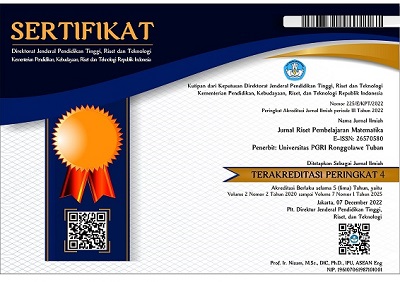Analisis Literasi Matematika Siswa dengan Gaya Berpikir Sekuensial Konkret dan Acak Konkret dalam Menyelesaikan Soal Tipe AKM
DOI:
https://doi.org/10.55719/jrpm.v5i2.836Keywords:
Analysis, Mathematical Literacy, Thinking style, AKMAbstract
This research aimed to describe the mathematical literacy of students with concrete sequential and concrete random thinking styles in solving AKM-type questions. The type of research used is descriptive research with a qualitative research approach. The subjects of this study were two students of class VIII A at SMP Negeri 17 Bintan consisting of one student each of concrete sequential and concrete random student thinking style. The selection of subjects was based on the results of the best students' mathematical literacy tests from concrete sequential and concrete random thinking styles. Data collection in this study was carried out using questionnaires, tests, and interviews. The research instruments used were a thinking-style questionnaire developed by John Park Le Tellier, AKM-type mathematical literacy test questions, and an interview guide. Data analysis in this study used data reduction, data display, and drawing conclusions. The results of the research show that students with a concrete sequential thinking style were able to meet the cognitive level of mathematical literacy knowing and applying level. Students with a concrete random thinking style are only able to meet the cognitive level of knowing mathematical literacy.
Downloads
References
DePorter, B., & Hernacki, M. (2000). Quantum Learning: Membiasakan Belajar Nyaman dan Menyenangkan. Penerbit Kaifa.
Kholifasari, R., Utami, C., & Mariyam, M. (2020). Analisis kemampuan literasi matematis siswa ditinjau dari karakter kemandirian belajar materi aljabar. Jurnal Derivat: Jurnal Matematika Dan Pendidikan Matematika, 7(2), 117–125. https://doi.org/10.31316/j.derivat.v7i2.1057
Masfufah, R., & Afriansyah, E. A. (2021). Analisis kemampuan literasi matematis siswa melalui soal PISA. Mosharafa: Jurnal Pendidikan Matematika, 10(2), 291–300. https://doi.org/10.31980/mosharafa.v10i2.825
Munahefi, D. N., Kartono, Waluya, B., & Dwijanto. (2020). Kemampuan Berpikir Kreatif Matematis pada Tiap Gaya berpikir Gregorc. PRISMA, Prosiding Seminar Nasional Matematika, 3(January), 650–659.
Muzaki, A., & Masjudin, D. (2019). Analisis Kemampuan Literasi Matematis Siswa. Moshafara: Jurnal Pendidikan Matematika, 8(3), 493–502. http://journal.institutpendidikan.ac.id/index.php/mosharafa
OECD. (2018). PISA 2015 Results in Focus. OECD.
Pusmenjar. (2020). AKM dan Implikasinya pada Pembelajaran. Pusat Asesmen dan Pembelajaran, Badan Penelitian, Pengembangan dan Perbukuan, Kementerian Pendidikan dan Kebudayaan.
Pusmenjar. (2021). Framework Asesmen Kompetensi Minimum (AKM). Pusat Asesmen dan Pembelajaran, Badan Penelitian, Pengembangan dan Perbukuan, Kementerian Pendidikan dan Kebudayaan.
Sugiyono. (2012). Metode Penelitian Kuantitatif, Kualitatif, dan R&D. Alfabeta.
Sulistiani, E., & Masrukan. (2017). Pentingnya Berpikir Kritis dalam Pembelajaran Matematika untuk Menghadapi Tantangan MEA. PRISMA, Prosiding Seminar Nasional Matematika, 605–612. https://journal.unnes.ac.id/sju/index.php/prisma/article/view/21554ite
Downloads
Published
How to Cite
Issue
Section
License
Copyright (c) 2023 Jurnal Riset Pembelajaran Matematika

This work is licensed under a Creative Commons Attribution-ShareAlike 4.0 International License.
Penulis yang menerbitkan dengan jurnal ini menyetujui persyaratan berikut:
- Penulis mempertahankan hak cipta dan memberikan jurnal hak publikasi pertama dengan karya yang dilisensikan secara bersamaan di bawah Lisensi Internasional Creative Commons Attribution-ShareAlike 4.0 yang memungkinkan orang lain untuk berbagi karya dengan pengakuan kepenulisan karya dan publikasi awal di jurnal ini.
- Penulis dapat membuat pengaturan kontrak tambahan yang terpisah untuk distribusi non-eksklusif dari versi jurnal yang diterbitkan dari karya tersebut (misalnya, mempostingnya ke repositori institusional atau menerbitkannya dalam sebuah buku), dengan pengakuan publikasi awalnya di jurnal ini.
- Penulis diizinkan dan didorong untuk memposting karya mereka secara online (misalnya, di repositori institusional atau di situs web mereka) sebelum dan selama proses pengiriman, karena dapat menghasilkan pertukaran yang produktif, serta kutipan lebih awal dan lebih besar dari karya yang diterbitkan.









